Multiple Choice
Identify the
choice that best completes the statement or answers the question.
|
|
|
1.
|
Which relation is a function?
a. | {(–3, –2), (–1, 3), (0, –2), (3, 4)} | c. | {(–7,
–7), (–2, 5), (–1, 6), (–2, –5)} | b. | {(0, 1), (3, 2), (5,
–3), (0, 2)} | d. | {(–4, –7), (–9, 5), (4, –2), (–9,
0)} |
|
|
|
2.
|
Which graph is not a function?
|
|
|
3.
|
Evaluate  for  .
|
|
|
4.
|
What are the domain and range of the function  ?
|
|
|
5.
|
What are the domain and range of the relation that contains the points
{(–16, –10), (–14, –8), (–11, –3), (–7, 4), (–1,
–8)}?
a. | Domain = {–16, –14, –11, –10, –8, –7, –3,
–1, 4}
Range = {–16, –14, –11, –10, –8, –7, –3,
–1, 4} | b. | Domain = {–10, –8, –3, 4}
Range = {–16, –14,
–11, –7, –1} | c. | Domain = {–16, –14, –11,
–7, –1}
Range = {–10, –8, –3, 4} | d. | Domain = { } }
Range = { } } |
|
|
|
6.
|
What are the domain and range of the function  ?
|
|
|
7.
|
What are the domain and range of the function  ?
|
|
|
8.
|
Which of the following is NOT a transformation that can be used to graph the
function  from the parent function? a. | Vertical translation 2 units up | b. | Horizontal compression by a factor of  | c. | Reflection in the x-axis | d. | Horizontal translation 4 units to the
right |
|
|
|
9.
|
Which of the following is the graph of the function  ? (The parent function
is dotted.)
|
|
|
10.
|
Simplify. 
|
|
|
11.
|
A rectangle has length (3x + 5) cm and width (2x – 1) cm.
What is the area of the rectangle?
|
|
|
12.
|
Expand and simplify. 
|
|
|
13.
|
Which of the following are factors for the polynomial  ? a. | (2x + 6)(3x + 3) | c. | 3(x + 6)(x +
3) | b. | 6(x + 3)(x + 3) | d. | 6(x + 9)(x +
6) |
|
|
|
14.
|
Which of the following are factors for the polynomial  ? a. | (9x – 16)(x + 1) | c. | (9x + 4)(x –
4) | b. | (3x – 4)(3x – 4) | d. | (3x + 4)(3x –
4) |
|
|
|
15.
|
Simplify. 
|
|
|
16.
|
What are the restrictions on the variable for  ?
|
|
|
17.
|
Simplify. 
|
|
|
18.
|
Simplify. 
|
|
|
19.
|
Simplify.  a. | 48x – 60 | c. |  | b. | 1 | d. | 8x –
10 |
|
|
|
20.
|
Simplify. 
|
|
|
21.
|
Simplify. 
|
|
|
22.
|
Simplify. 
|
|
|
23.
|
Simplify. 
|
|
|
24.
|
Which of the following is true about the parabola for the function  ? a. | The y-intercept is 0. | c. | The axis of symmetry is x =
–4. | b. | The vertex is (4, 5). | d. | The parabola opens down. |
|
|
|
25.
|
What is the function for the graph shown? 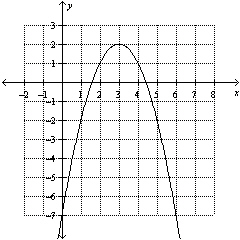
|
|
|
26.
|
The points (–3, 5) and (7, 5) are the same distance from the vertex of
their parabola. What is the equation for the axis of symmetry of the parabola?
a. | x = 5 | c. | x = –3 | b. | x = 0 | d. | x = 2 |
|
|
|
27.
|
The Canada Calendar Company reduces the prices of its calendars each January.
The function  models the company’s profits, where x is
the price of a calendar in dollars. At what calendar price will the company receive maximum
profits?
|
|
|
28.
|
Which of the following quadratic functions will have a minimum value?
|
|
|
29.
|
What is the minimum value for the function  ? Round to two decimal
places.
|
|
|
30.
|
What is the minimum value for the function  ?
|
|
|
31.
|
Which of the following expresses  in simplest form?
|
|
|
32.
|
Which of the following expresses  in simplest form?
|
|
|
33.
|
Which of the following expresses  in simplest form? a. | 180 | c. |  | b. |  | d. | 320 |
|
|
|
34.
|
Which of the following expresses  in simplest form?
|
|
|
35.
|
Which of the following expresses  in simplest form?
|
|
|
36.
|
Which of the following are roots of the equation  ? a. | x = –4, 7 | c. | x = –7, 4 | b. | x =
–28, 0 | d. | x =
–24, 4 |
|
|
|
37.
|
Which of the following are approximate roots of the equation  ? a. | x  0.4, 0.67 0.4, 0.67 | c. | x  1.38,
11.63 1.38,
11.63 | b. | x  0.69, 5.81 0.69, 5.81 | d. | x  –13.13,
3.25 –13.13,
3.25 |
|
|
|
38.
|
A model rocket is launched off the top of a table. The height of the rocket is
given by the function  , where h( t) is the height in metres and
t is the time in seconds. How long will it take for the rocket to reach the ground? a. | 0.13 s | c. | 18.79 s | b. | 18.76 s | d. | 0.13 s and 18.79
s |
|
|
|
39.
|
How many zeros are in the solution to the function  ?
|
|
|
40.
|
Which of the following is equivalent to the expression  ?
|
|
|
41.
|
Which of the following is equivalent to the expression  ?
|
|
|
42.
|
Which of the following is equivalent to the expression  ?
|
|
|
43.
|
What is  in exponent form?
|
|
|
44.
|
Which of the following is equivalent to the expression  ?
|
|
|
45.
|
Which of the following is equivalent to the expression  ?
|
|
|
46.
|
Which function describes exponential decay?
|
|
|
47.
|
The growth in population of a town since 2000 is given, in thousands, by the
function  . In which year will the population expect to reach
70 000?
|
|
|
48.
|
A 300 g sample of thorium-234 has a half-life of 24 days. The mass of thorium,
in grams, that remains after t days can be modelled by  . What mass will
remain after 31 days? a. | 122.5 g | c. | 177.5 g | b. | 150 g | d. | 193.75 g |
|
|
|
49.
|
Which function describes exponential growth?
|
|
|
50.
|
The population of a small village has grown at an annual rate of approximately
5.5%. How long will it take for its population of 3200 people to double at this growth rate?
a. | about 1.5 years | c. | about 13 years | b. | about 11 years | d. | about 16 years |
|
|
|
51.
|
Determine the length of the hypotenuse of the triangle to the nearest tenth of a
metre. 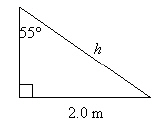 a. | 3.1 m | c. | 2.1 m | b. | 2.4 m | d. | 2.9 m |
|
|
|
52.
|
Determine the exact value of  .
|
|
|
53.
|
Using the appropriate special triangle, determine  if  for  .
|
|
|
54.
|
For the angle  moving counter-clockwise in standard position,
determine which primary trigonometric ratio is positive. a. | sine | c. | tangent | b. | cosine | d. | none are
positive |
|
|
|
55.
|
|
|
|
56.
|
Use the trigonometric ratio  to determine which of the following
is the correct value of  to the nearest degree if  .
|
|
|
57.
|
 lies on the terminal arm of an angle in standard
position. What is the value of the principal angle  to the nearest degree?
|
|
|
58.
|
Determine the correct simplification of the expression  .
|
|
|
59.
|
Determine the correct simplification of the expression  .
|
|
|
60.
|
Which of the following completes the missing step to the following
proof.  L.S.:  = ??? =   = R.S.
|
|
|
61.
|
Determine the measure of the angle  to the nearest degree. 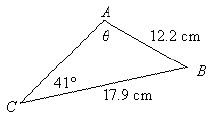
|
|
|
62.
|
Determine  to the nearest degree for the triangle with the given
information. a = 3.7 m, b = 4.9m, 
|
|
|
63.
|
Determine the measure of the angle  to the nearest degree. 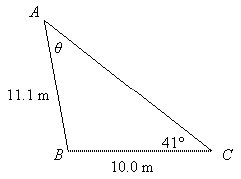
|
|
|
64.
|
Determine x to the nearest tenth of a metre. 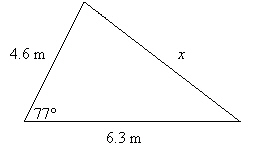 a. | 7.5 m | c. | 6.2 m | b. | 7.9 m | d. | 6.9 m |
|
|
|
65.
|
In  , a = 5.4 m, b = 7.2 m, and c =
10.0 m. Determine  to the nearest degree.
|
|
|
66.
|
In  , a = 9.4 m, b = 16.1 m, and  . Determine  to the nearest degree.
|
|
|
67.
|
Determine the value of x to the nearest cm. 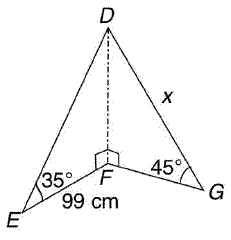 a. | 47 cm | c. | 74 cm | b. | 68 cm | d. | 98 cm |
|
|
|
68.
|
Frank is riding a Ferris wheel, where t is time in seconds. Suppose
the Ferris wheel is 20 m tall. Let  represent the height of Frank in m
above or below the centre of the Ferris wheel. How long does it take to make two complete
cycles on the Ferris wheel? Assume there are no stops. a. | 60 s | c. | 45 s | b. | 30 s | d. | 120 s |
|
|
|
69.
|
A spring bounces up and down according to the model  , where  is the
displacement in cm from the rest position and t is time in seconds. What is the
range?
|
|
|
70.
|
Without graphing, determine the equation of the axis of the function  .
|
|
|
71.
|
Without graphing, determine the period of the function  .
|
|
|
72.
|
Determine the equation of a sine function that would have a range of  and a period of  .
|
|
|
73.
|
For an investment of $20 000 at 7.2%/a compounded semi-annually for 7 years,
what is the total interest earned?
a. | $12 814.56 | c. | $32 936.72 | b. | $32 814.56 | d. | $52 936.72 |
|
|
|
74.
|
How much is the future value of an investment of $6300 at 2.6%/a compounded
weekly for 1.5 years?
a. | $6347.31 | c. | $6550.49 | b. | $6420.81 | d. | $6800.98 |
|
|
|
75.
|
Maureen invests $1500 every 3 months at 5.2%/a compounded quarterly for 5 years.
How much interest will she earn after the 5th year?
a. | $821.62 | c. | $4010.64 | b. | $1942.14 | d. | $34 010.64 |
|
|
|
76.
|
Fayad wants to invest money every month for 25 years. He would like to have $250
000 at the end of the 25 years. If he invests in an account at 6.6%/a compounded monthly, how much
does he need to invest each month?
a. | $328.67 | c. | $1881.90 | b. | $760.64 | d. | $4185.36 |
|
|
|
77.
|
Every 6 months, Lucy invests $900 at 2.8%/a compounded semi-annually for 12
years. What is the value of the first investment at the end of 12 years?
a. | $925.20 | c. | $1256.47 | b. | $1239.13 | d. | $1274.06 |
|
|
|
78.
|
Sal and Kendra each invest $400 every month for 5 years. Sal’s bank gives
him 5.4%/a compounded monthly. Kendra’s bank gives her 6%/a compounded monthly. How much more
will Kendra have in her account at the end of 5 years?
a. | $240.00 | c. | $572.72 | b. | $426.12 | d. | $27 908.01 |
|